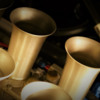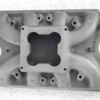Here's the problem you are running into. It is true that 48IDA's were run in factory sponsored comp cars in the '60s and early '70s.
It is also true that they exist due to Ford's financial investment in them with Weber.
Almost all of those Ford engines were 289 Fords. The "factory" racers used special 289 heads that are now referred to as GT40 heads. The Group 4 Pantera is one of the exceptions.
The camshaft they were using, I don't know specifically. It may have been a version of what we now call the 289 Lemans cam but likely the cams varied from team to team.
Those cams initially were ground for Shelby by Sullivan. There are several versions of them. Eventually Ford put them in their service parts and referred to their version as the Lemans cam.
It had/has 63 degrees of overlap. So where ever the intake valve close is, the thing is going to produce reversion. The plate over the top of the Webers on the GT40's is really a collection plate for the fuel droplets. That way they could control where the fuel dripped on the engine and avoid the hot headers.
My only remark about them is that by today's standards they are very tame with not a lot of valve lift, just more duration. Very disappointing in a street car.
With this configuration in a 289 (4.7L), 48mm throttles were found to be restrictive at around 6,500 rpm WITH 42mm chokes!
I do not know what 44mm chokes in a 48IDA will run like. Probably better at WOT and terrible on the street?
The 351c iron head numbers work out to requiring a 51mm throttle bore. That configuration naturally from Weber doesn't exist.
If you examine the throats of the Pantera Weber intake manifold you should note that they are in fact 51mm.
The 427's actually need 58mm carbs. It's thought that only four sets of those were made. I don't know why.
Now, you CAN get 51mm "Webers". They are made by EMPI and really are not Weber products. They are Weber lookalikes.
What EMPI has done is bored out the throats of 48mm carbs to 51mm and installed the corresponding throttle plates. Everything else remains the same.
I have seen the carbs and there is a caution on them. They are very thin at the gasket mounting surface. I personally know no one who is using them so I cannot speak to the reliability factor with them.
However, these would be the carbs that THEORETICALLY you need to run to make the power that you are looking for and you would use 44mm chokes with.
I would GUESS that the camshaft you have would be adequate BUT I suspect that you are going to need to go to a cam grinder for a more precise one.
I am using that cam, with 1.72 ratio rockers. You might benefit from 1.80 ratio rockers possibly without changing cams but you would need to experiment with that and there MIGHT be an issue with rocker arm studs at the rpm's you are talking about going to. This would give you .634 lift. That will help you with more rpm's.
Also unless you are limited by racing rules that are sanctioning your car, I think that you MUST go to the aluminum aftermarket Cleveland heads.
There are several here that can attest to "Clevelands" in the 800hp range using aftermarket heads.
The issue there is that even though you are able to run that engine on "the street", you are really running a race engine with things like Jessel rocker arm assemblies that are likely to need to be rebuilt around every 1,000 miles or so.
The horsepower is there but it is a very expensive maintenance engine to care for.
As far as a Holley 850 carb making more power, yes. Absolutely. You could consider a Holley 950cfm three barrel or a 1050 Dominator if you can find an intake for them.
The Dominator is huge and takes up most of the intake manifold so it has the outrageous looks you want.
IF you want that look of an 8 stack system looking like Webers then you need to go to the "Inglese" efi system. By the time you get the cpu and set up, that's going to cost you around $8,000 right now and is going to take you a while to dial it in.
Unfortunately to get that one right where you want it, you can no longer tune that on the street and you are looking at track rental and a team to go with you to the track to test and tune it. So the power is there but there are other very serious considerations to get it.
You MUST do something with exhausts. If you are going under, talk to Pat Michal. If over, talk to Ron Mccall. Both are making step tube headers and you are going to need those to milk another 50hp or so out of the exhaust at those rpms.
I'm fine with my setup. I am a dinosaur. Frankly I don't think that I am capable of handling the car with more power. You would be entering into the vicinity of a professional race driver that practices day in and day out with the car and just drives it and doesn't maintain or repair the car themselves. That's not me.
Here's a pic of the Holley Dominator manifold to fit your iron 4v heads. Put a 1050 Dominator on it.
It's as impressive as the Webers are. This IS a full race manifold for that engine. I doubt you will have restriction issues with it.
My apologies for the long replies but there is no simple answer with a Weber 48 ida setup.



